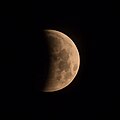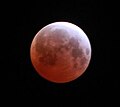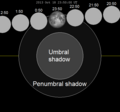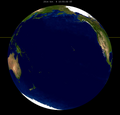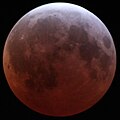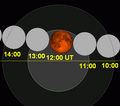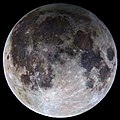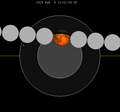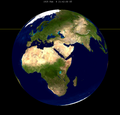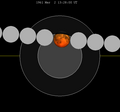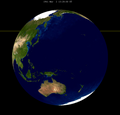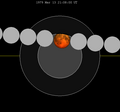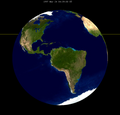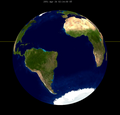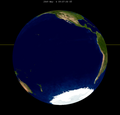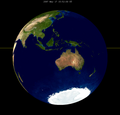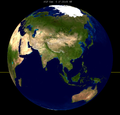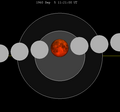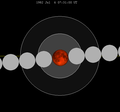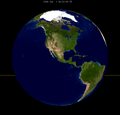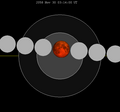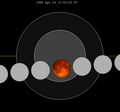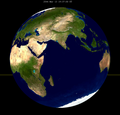Top Qs
Timeline
Chat
Perspective
April 2015 lunar eclipse
Total lunar eclipse of 4 April 2015 From Wikipedia, the free encyclopedia
Remove ads
A total lunar eclipse occurred at the Moon’s ascending node of orbit on Saturday, April 4, 2015,[1] with an umbral magnitude of 1.0019. A lunar eclipse occurs when the Moon moves into the Earth's shadow, causing the Moon to be darkened. A total lunar eclipse occurs when the Moon's near side entirely passes into the Earth's umbral shadow. Unlike a solar eclipse, which can only be viewed from a relatively small area of the world, a lunar eclipse may be viewed from anywhere on the night side of Earth. A total lunar eclipse can last up to nearly two hours, while a total solar eclipse lasts only a few minutes at any given place, because the Moon's shadow is smaller. Occurring about 3.1 days after apogee (on April 1, 2015, at 9:00 UTC), the Moon's apparent diameter was smaller.[2]
This lunar eclipse is the third of a tetrad, with four total lunar eclipses in series, the others being on April 15, 2014; October 8, 2014; and September 28, 2015.
This is the 30th member of Lunar Saros 132, and the first total eclipse of the series. The previous event was the March 1997 lunar eclipse, being slightly partial.
It occurred on Easter Sunday (Gregorian only).[3]: 152
Remove ads
Duration
Totality lasted only 4 minutes and 43 seconds,[4] making it the shortest lunar totality in almost five centuries since October 17, 1529 (which lasted 1 minute and 42 seconds). It was claimed by some that due to the oblateness of the Earth, it may have actually just been a partial eclipse.[5] It was the sixth total lunar eclipse out of nine with totality under 5 minutes in a five millennium period between 2,000 BC and 3,000 AD. The eclipsed moon was 12.9% smaller in apparent diameter than the supermoon September 2015 lunar eclipse, measured as 29.66' and 33.47' in diameter from the center of the Earth. It occurred 3 days past apogee at 29.42'.
Remove ads
Background
A lunar eclipse occurs when the Moon passes within Earth's umbra (shadow). As the eclipse begins, Earth's shadow first darkens the Moon slightly. Then, the shadow begins to "cover" part of the Moon, turning it a dark red-brown color (typically - the color can vary based on atmospheric conditions). The Moon appears to be reddish because of Rayleigh scattering (the same effect that causes sunsets to appear reddish) and the refraction of that light by Earth's atmosphere into its umbra.[6]
The following simulation shows the approximate appearance of the Moon passing through Earth's shadow. The Moon's brightness is exaggerated within the umbral shadow. The southern portion of the Moon will be closest to the center of the shadow, making it darkest, and most red in appearance.
Remove ads
Visibility
The eclipse was completely visible over northeast Asia, eastern Australia, the Pacific Ocean, and western North America, seen rising over Asia and western Australia and setting over North and South America.[7]
  |
 Visibility map |
Timing
Summarize
Perspective
† The Moon was not visible during this part of the eclipse in this time zone.

The timing of total lunar eclipses are determined by its contacts:[8]
|
Remove ads
Gallery
 Progression from Bali, Indonesia | |
 Time-lapsed image from Taiwan |
 Sequence from Fox Observatory in Sunrise, Florida |
 Sequence from Melbourne, Florida |
 Progression from St. Louis, Missouri |
- Toronto, Canada, 9:54 UTC
- Auckland, New Zealand, 9:54 UTC
- Macon, Georgia, 10:54 UTC
- Mexico City, Mexico, 10:59 UTC
- Minneapolis, Minnesota, 11:09 UTC
- Chicago, Illinois, 11:36 UTC
- Melbourne, Australia, 11:46 UTC
- Denver, Colorado, 11:50 UTC
- Tai Po, Hong Kong, 12:01 UTC
- Santa Clara County, California, 12:02 UTC
- Las Vegas, Nevada, 12:03 UTC
- Rio Rancho, New Mexico, 12:13 UTC
- Bangkok, Thailand, 12:37 UTC
- Hirosaki, Aomori, 12:56 UTC
- Pune, India, 13:38 UTC
Remove ads
Eclipse details
Shown below is a table displaying details about this particular solar eclipse. It describes various parameters pertaining to this eclipse.[9]
Remove ads
Eclipse season
This eclipse is part of an eclipse season, a period, roughly every six months, when eclipses occur. Only two (or occasionally three) eclipse seasons occur each year, and each season lasts about 35 days and repeats just short of six months (173 days) later; thus two full eclipse seasons always occur each year. Either two or three eclipses happen each eclipse season. In the sequence below, each eclipse is separated by a fortnight.
Remove ads
Related eclipses
Summarize
Perspective
Eclipses in 2015
- A total solar eclipse on March 20.
- A total lunar eclipse on April 4.
- A partial solar eclipse on September 13.
- A total lunar eclipse on September 28.
Metonic
- Preceded by: Lunar eclipse of June 15, 2011
- Followed by: Lunar eclipse of January 21, 2019
Tzolkinex
- Preceded by: Lunar eclipse of February 21, 2008
- Followed by: Lunar eclipse of May 16, 2022
Half-Saros
- Preceded by: Solar eclipse of March 29, 2006
- Followed by: Solar eclipse of April 8, 2024
Tritos
- Preceded by: Lunar eclipse of May 4, 2004
- Followed by: Lunar eclipse of March 3, 2026
Lunar Saros 132
- Preceded by: Lunar eclipse of March 24, 1997
- Followed by: Lunar eclipse of April 14, 2033
Inex
- Preceded by: Lunar eclipse of April 24, 1986
- Followed by: Lunar eclipse of March 13, 2044
Triad
- Preceded by: Lunar eclipse of June 3, 1928
- Followed by: Lunar eclipse of February 3, 2102
Lunar eclipses of 2013–2016
This eclipse is a member of a semester series. An eclipse in a semester series of lunar eclipses repeats approximately every 177 days and 4 hours (a semester) at alternating nodes of the Moon's orbit.[10]
The penumbral lunar eclipse on May 25, 2013 occurs in the previous lunar year eclipse set, and the penumbral lunar eclipse on August 18, 2016 occurs in the next lunar year eclipse set.
Saros 132
This eclipse is a part of Saros series 132, repeating every 18 years, 11 days, and containing 71 events. The series started with a penumbral lunar eclipse on May 12, 1492. It contains partial eclipses from August 16, 1636 through March 24, 1997; total eclipses from April 4, 2015 through August 2, 2213; and a second set of partial eclipses from August 13, 2231 through November 30, 2411. The series ends at member 71 as a penumbral eclipse on June 26, 2754.
The longest duration of totality will be produced by member 36 at 106 minutes, 6 seconds on June 9, 2123. All eclipses in this series occur at the Moon’s ascending node of orbit.[11]
Eclipses are tabulated in three columns; every third eclipse in the same column is one exeligmos apart, so they all cast shadows over approximately the same parts of the Earth.
Tritos series
This eclipse is a part of a tritos cycle, repeating at alternating nodes every 135 synodic months (≈ 3986.63 days, or 11 years minus 1 month). Their appearance and longitude are irregular due to a lack of synchronization with the anomalistic month (period of perigee), but groupings of 3 tritos cycles (≈ 33 years minus 3 months) come close (≈ 434.044 anomalistic months), so eclipses are similar in these groupings.
Inex series
This eclipse is a part of the long period inex cycle, repeating at alternating nodes, every 358 synodic months (≈ 10,571.95 days, or 29 years minus 20 days). Their appearance and longitude are irregular due to a lack of synchronization with the anomalistic month (period of perigee). However, groupings of 3 inex cycles (≈ 87 years minus 2 months) comes close (≈ 1,151.02 anomalistic months), so eclipses are similar in these groupings.
Half-Saros cycle
A lunar eclipse will be preceded and followed by solar eclipses by 9 years and 5.5 days (a half saros).[13] This lunar eclipse is related to two total solar eclipses of solar saros 139.
Remove ads
See also
Notes
External links
Wikiwand - on
Seamless Wikipedia browsing. On steroids.
Remove ads






